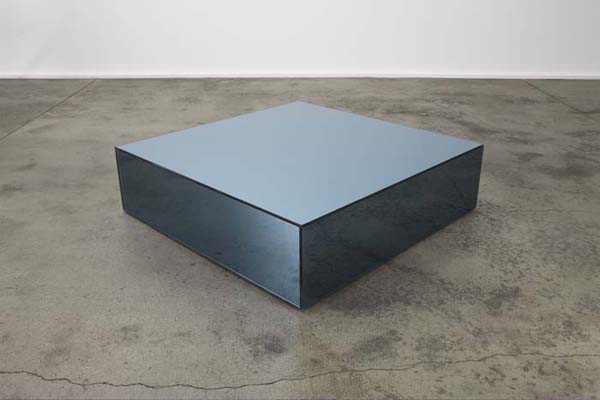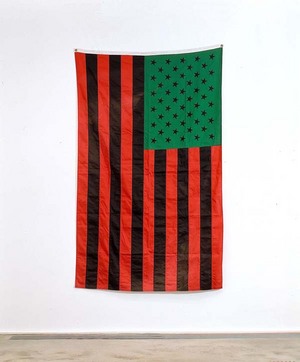This is an archive of the ArtCat Zine, 2007-2009. Please visit our new project, IDIOM.
Quiet Politics at Zwirner & Wirth

Quiet Politics
Zwirner & Wirth - 32 East 69th Street, New York NY
26 June - 29 August 2008
If "doing something poetic can become political, and sometimes doing something political can become poetic," then what is left of each position following said becoming? This is the question at the heart of Quiet Politics, a group exhibition recently closed at Zwirner & Wirth's uptown location. What is left of the political when it has become poetic and vice-versa, and further, if there isn't a more tenacious opposition at work here than indicated. Does the political, if it is worthy of that name, necessarily eclipse the poetic? Indeed Quiet Politics seems bent on pushing this question to the limit by presenting a collection of works that move from the loudly political to the obliquely so, if at all.
Thus David Hammons' U.N.I.A. - an American flag done up in the colors of the Pan-African flag - doesn't seem quiet at all, never mind silent. If anything it is its poeticism that is relegated to a hushed whisper, a sort of formal sarcasm and nothing more. Similarly, Micheal Brown's literally ham-fisted broken mirror/shattered glass routine In The Meantime... lands like a slogan shouted against mimetic subtlety in favor of a classically Brechtian didacticism. Fortunately, both pieces inhabit the front room, providing both a transition from the clumsily branded pageant of the Upper East Side and juxtaposition with the quieter work in the back.
The back room is a definite curatorial success perched precariously above a swirling incoherence, with each visceral triumph - and there are several - the show threatens to dissolve beneath a contextual and chronological breadth that betrays either ignorance or mendacity. The works span more than two decades, and relate to each other so tangentially that all but the sloppiest eclecticism or most banal conceptual rubric fails to account for their cohabitation; that is, from an art-historical perspective. Indeed, perhaps this formal promiscuity might be entirely the point, aiming to tell us something about politics rather than something about art. To which we might further wonder if any such presentation could stand assessment by some meta-historical accounting of political strategies, the larger situation being what it is, and, still further and following, whether such invocations, of politics, of power, remain but rosary beads; momentarily relieving the moral constipation of our continued impotence. But then Quiet Politics would hardly be the worst offender in this regard. All that aside, there remains a striking satisfaction to be had in the peculiar effect of these works' combined immanence. The centerpiece is Felix Gonzales-Torres' untitled (Fear), from 1992, a squat, shiny, bluish box that would reflect the works around it, if only it were high enough. Among the surrounding works are three high points: Rosemarie Trockel's Balaklava, from 1986, five knitted wool masks emblazoned with different symbols, from swastikas to Playboy bunnies, Jennifer Allora and Guillermo Calzadilla's The Nature of Conflict, from 2004, which places containers of water and used motor oil side-by-side beneath a photo of the two liquids mixed together in a gutter somewhere, and Adel Abdessemed's Cocktail from 2007, a series of music stands holding charcoal drawings of what appears to be protesters in the act of throwing stones marked by sparkly plastic stick-on earrings. In each of these works there is a considered deployment of repetition, reiteration, and movement towards an implication of the methodologies of power. If not quietly political, they are certainly not loudly partisan either, as they approach charged structures of representation with an openness warranting their categorization as poetic.
This is in contrast to the other two artists in the room, Christopher Williams and Roni Horn whose respective photographs tilt too far towards an ingrown hermeticism; though perhaps political in a different context, they are here too easily effaced.
In this respect the best metaphor for the show comes by way of Robert Gober, whose Untitled, 1991, appears at first to be a found newspaper page. Upon closer inspection however, it becomes clear the artist has spliced together wedding announcements alongside gruesome short articles about pets dying, child abuse, an even an item announcing his own drowning as a boy of six. Considering the work, one is forced to confront the reality of a shared vocabulary in which politics, sensationalism, and trivialities are presented side by side, forcing the concerned party to mine the page (er, text) for significance while simultaneously guarding against emotional ambush. Politics here is not so much quiet as it is a garish blast of white noise demanding careful tuning to be heard for what it is. By presenting a quasi-historical patchwork of different political reckonings, Quiet Politics succeeds chiefly in begging the question of a relationship it is - officially at least - all too comfortable simply asserting. However, viewed as a sort of experimental poetic spectrum wherein we are challenged to either locate or deny political relevance or efficacy, the show must be considered a success.
ZINE
HOME
TIPS / COMMENTS
CATEGORIES
CONTRIBUTORS
- Greg Afinogenov
- B. Blagojevic
- Adda Birnir
- Susannah Edelbaum
- Julie Fishkin
- Paddy Johnson
- Jessica Loudis
- Christopher Reiger
- Andrew Robinson
- Peter J. Russo
- Blythe Sheldon
- S.C.Squibb
- Hrag Vartanian

